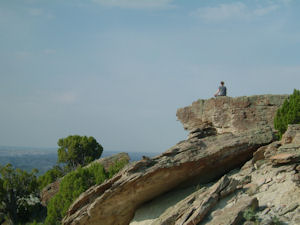A rite of passage
Peoples of many cultures have created traditions and ceremonies involving solo time in wild  nature. In North America, the plains peoples are the most well-known groups to use the ancient practice of the vision quest. John Murray recounts, in editors Michael Tobias and Georgianne Cowan’s The Soul of Nature, a story of discovering a vision quest site in Rocky Mountain National Park. Archaeologists from Colorado State University and the National Park Service studied the site and determined it had been used for vision quests and fasts from 10,000 years ago until about 500 years ago. This is remarkable! Long before the civilizations of Mesopotamia and Egypt, the first peoples of North America had been using spiritual ceremony to help their people live and thrive.
nature. In North America, the plains peoples are the most well-known groups to use the ancient practice of the vision quest. John Murray recounts, in editors Michael Tobias and Georgianne Cowan’s The Soul of Nature, a story of discovering a vision quest site in Rocky Mountain National Park. Archaeologists from Colorado State University and the National Park Service studied the site and determined it had been used for vision quests and fasts from 10,000 years ago until about 500 years ago. This is remarkable! Long before the civilizations of Mesopotamia and Egypt, the first peoples of North America had been using spiritual ceremony to help their people live and thrive.
The vision quest was used as a rite of passage to mark the transition from childhood to adulthood. The quester would fast from food, people, and shelter. In some groups the faster would go forth naked, with only a bear-skin robe for warmth and protection. Severing from her people (I don’t know for sure if young women participated in this ceremony, or if it was only males in traditional societies who used this rite of passage, but today they definitely do!), the quester would enter a threshold space—a space between worlds, a place of spirit. The faster would be invisible to her people—a spirit form—until returning back across the threshold, sometimes after four days and four nights of fasting, sometimes for different periods of time. Upon returning, the quester would tell her story of the fast. The story would be received by her elders, and the entire community would know that the quester had successfully crossed over into adulthood. She might have received a vision, or a gift to bring back to her people. Incorporation, the final stage of the vision fast process, would involve living her gift or vision—bringing it back to her people, and making it real.
There are historical accounts of Native Americans who saw the coming of Christopher Columbus’s ship in a vision, but didn’t know what it was because they had never seen a ship before. There are many accounts of first peoples visionaries seeing the coming of the “white man” and the ensuing drastic effects on their way of life.
Today, First Nation peoples in some parts of North America still use the vision quest ceremony. Contemporary groups such as the School of Lost Borders and Monkey Valley Retreat Centre also put people out on the land to undergo the rite of passage of the vision fast. See the Links page for other contemporary organizations who offer vision fasts.